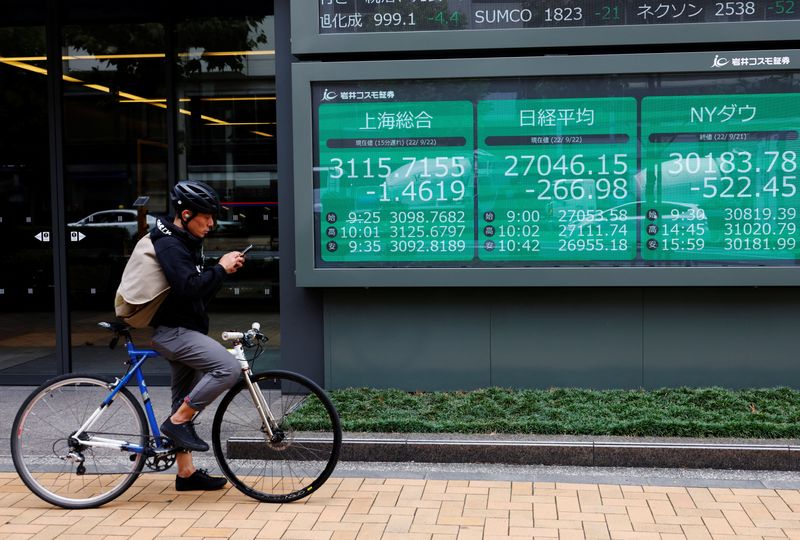Asia markets roiled by recession risk, rampant dollar
2022.09.28 01:05
[ad_1]

© Reuters. FILE PHOTO: A man on a bicycle stands in front of an electronic board showing Shanghai stock index, Nikkei share price index and Dow Jones Industrial Average outside a brokerage in Tokyo, Japan September 22, 2022. REUTERS/Kim Kyung-Hoon
By Wayne Cole
SYDNEY (Reuters) – Asian share markets tumbled on Wednesday as surging borrowing costs intensified fears of a global recession, spooking investors into the arms of the safe-haven dollar and punishing currencies across the region.
Yields on U.S. 10-year Treasuries were shoved above 4.0% for the first time since 2010 as markets wagered the Federal Reserve might have to take rates past 4.5% in its crusade against inflation.
Sterling also came under renewed pressure as Moody’s (NYSE:) warned that unfunded UK tax cuts would be “negative” for the country’s credit standing, deepening a damaging selloff in gilts.
“It is now clear that central banks in advanced economies will make the current tightening cycle the most aggressive in three decades,” said Jennifer McKeown, head of global economics at Capital Economics.
“While this may be necessary to tame inflation, it will come at a significant economic cost.
“In short, we think the next year will look like a global recession, feel like a global recession, and maybe even quack like one, so that’s what we’re now calling it.”
Surging rates and slowing growth is not a good mix for equities and MSCI’s broadest index of Asia-Pacific shares outside Japan fell 2.0% to its lowest since April 2020.
shed 2.2% and South Korean stocks fell 3.0% to a two-year low. Chinese blue chips lost 0.7%.
got caught in the bearish mood and slipped 0.8%, while Nasdaq futures dropped 1.0%. This would be the ‘s seventh session of losses and threaten the technically-important 200-week average at 3,590.
EUROSTOXX 50 futures fell 1.0%, while futures lost 1.1% as European borrowing costs blew out.
“European sovereign yields have soared to multi-year highs amid concerns about UK policy-making and a right-ward shift of Italian politics in the midst of still elevated inflation,” wrote analysts at JPMorgan (NYSE:) in a note.
“The Italian 10-year spread to the German Bund has eclipsed 250bp, well above the 200bp mark we believe makes the ECB uncomfortable.”
Shaking investor confidence has been the collapse in sterling and UK bond prices, which could force some fund managers to sell other assets to cover resulting losses.
Underlining the risk of yet higher interest rates, the chief economist at the Bank of England said the tax cuts would likely require a “significant policy response”.
Moody’s on Tuesday warned the UK government that large unfunded tax cuts were “credit negative” and could undermine the government’s fiscal credibility.
MORE RISK PREMIUM, PLEASE
George Saravelos, global head of FX strategy at Deutsche Bank (ETR:) Research, said investors now wanted more to finance the country’s deficits, including a 200-basis-point rate hike by November and a terminal rate up at 6%.
“This is the level of risk premium that the market now demands to stabilize the currency,” said Saravelos. “If this isn’t delivered, it risks further currency weakening, further imported inflation, and further tightening, a vicious cycle.”
Sterling was under fire again at $1.0644, with its bounce from Monday’s record trough of $1.0327 stopping far short of the $1.1300 level held before last week’s UK Budget.
Yields on British 10-year gilts have risen a staggering 119 basis points in just four sessions to reach 4.50%, the sharpest such move since at least 1979. [GBP/]
The safe-haven dollar has been a major beneficiary from the rout in sterling, rising to a fresh 20-year peak of 114.680 against a basket of currencies.
The dollar held at 144.75 yen, testing the resolve of the Japanese authorities to protect the 145.00 level after last week’s intervention.
The euro slipped anew to $0.9552 and back toward last week’s two-decade low of $0.9528.
The dollar also touched a record high on the offshore-traded at 7.2387, having risen for eight straight sessions.
The mounting pressure on emerging market currencies from the dollar’s rise is in turn adding to risks that those countries will have to keep lifting interest rates and undermine growth.
The ascent of the dollar and bond yields has also been a drag for gold, which was hovering at $1,624 an ounce after hitting lows not seen since April 2020. [GOL/]
Oil prices fell again as demand worries and the strong dollar offset support from U.S. production cuts caused by Hurricane Ian. [O/R]
fell $1.17 to $85.03 a barrel, while lost $1.10 cents to $77.40 per barrel.
[ad_2]
Source link








